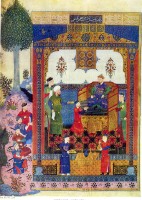These designs have been taken from 15th century miniatures that were painted as illustrations to hand-copied books of poetry and history. Many of our designs have been revived for the first time in 500 years and we are most grateful to the Royal Asiatic Society and the British Library for giving us access to some of their original manuscripts.
Whilst many 16th century carpets can still be seen today in museums around the world, 15th century carpets have simply not withstood the test of time and the demands of feet. As a result there are no known intact Timurid rugs in existence any more. However, there are a few surviving fragments. The most famous of these is now on display in the Benaki Museum in Greece. We have taken this fragment design and revived it once more. As no border appears in the fragment, we have used different Timurid borders, to stunning effect. We have also produced a number of suzannis with this design.
Apart from these few fragments, the only source left for Timurid Carpets are the miniatures themselves. Painted on vellum with water colours and leaf gold, large workshops known as 'kitabtkhana' were set up around the Timurid empire, employing the finest painters and craftspeople to produce hand-bound and handwritten books.
Aware of the stricture placed on Muslims not to create representative art, the miniaturists would attempt to mollify offence by ensuring that no humans ever took the centre of the miniature, this being a space reserved for God, and also painted the miniatures from the perspective of a minaret. This has proved particularly useful for us as the carpets - appearing from a birds-eye view - are then much easier to reproduce. We transpose these designs onto graph-paper and then weave them, bringing the glory of Timurid carpets back to life once more.
The Timurid era brought together a fusion of Persian and Turkic/Mongol influences which can also be seen in the carpet designs themselves. Perhaps most distinctive are the Timurid carpet borders. These borders were originally repeating letters of the Kufic script, which became stylised over time. They are one way of easily spotting a Timurid design.









